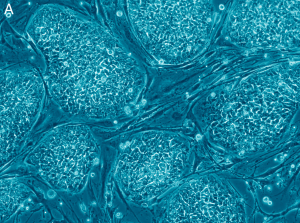 Stem cell research has elicited both excitement and controversy since its earliest days. Hematopoietic stem cell transplants have been employed for some time in the treatment of certain blood cancers. More recently, researchers have reported clinical successes in using bone marrow transplants to treat sickle cell disease as well as multiple sclerosis, where bone marrow stem cells have been used in clinical trials to slow disease progression.
Stem cell research has elicited both excitement and controversy since its earliest days. Hematopoietic stem cell transplants have been employed for some time in the treatment of certain blood cancers. More recently, researchers have reported clinical successes in using bone marrow transplants to treat sickle cell disease as well as multiple sclerosis, where bone marrow stem cells have been used in clinical trials to slow disease progression.
Advances with embryonic stem cells (ESCs), which are pluripotent cells (meaning they can give rise to various organs or tissue types, or divide and renew themselves) have come slower. Research with ESCs has often been controversial and was greatly hindered for a number of years by a 2001 executive order from U.S. President George W. Bush, who banned the National Institutes of Health from funding embryonic stem cell research other than from 60 already existent cell lines. Those research restrictions were eventually lifted in 2009 by an executive order from President Barack Obama. Recently, we have seen the first promising clinical results using ESCs to treat age-related macular degeneration (AMD), a condition that progressively leads to blindness.
On April 4, Science Translational Medicine published the results of a small Phase 1 safety study conducted by researchers at the University of Southern California’s Keck School of Medicine that implanted laboratory engineered ESCs behind the retinas of five patients with AMD to replace damaged retinal pigment epithelial cells. The aim of the study was primarily to demonstrate that such implants were safe and well tolerated, but preliminary results also showed some beneficial effects from the treatment. Progressive vision loss was halted in four patients, one patient experienced a 17 letter improvement in visual acuity, and two showed improved ability to visually fixate on a specific location, a capability required for reading. Even more promising results have been reported by researchers at Moorfield’s Eye Hospital in London. Several patients with AMD who received a retinal ESC “eye patch” reported significant improvements in their vision and quality of life.
Drug developers are increasingly investing in ESC research and development. Novo Nordisk has a major stem cell program in the area of Type 1 diabetes and hopes to enter clinical testing with a product candidate within the next few years. That company is also looking to develop stem cell therapies for such conditions as Parkinson’s disease, chronic heart failure, and AMD. Additionally, Sigilon Therapeutics and Lilly have teamed up on a Type 1 diabetes stem cell program, and start-up Semma Therapeutics is also developing cell therapy for that condition.
The U.S. Food and Drug Administration (FDA) has voiced safety concerns about many stem cell efforts, clamping down on a number of clinics that have sprung up with little oversight to commercialize stem cell procedures, sometimes with serious adverse effects to patients. However, FDA Commissioner Scott Gottlieb and the Director of the Center for Biologics Evaluation and Research, Peter Marks, recently authored a special report in the New England Journal of Medicine conceding that the conventional drug approval paradigm is not appropriate for stem cell products, whose novelty requires a more flexible path to approval. The authors proposed that the FDA use the expanded authority granted to the agency by the 21st Century Cures Act, which includes a Regenerative Medicine Advanced Therapy (RMAT) designation aimed at speeding up the review of stem cell therapies, tissue-based products, and gene therapy treatments. The RMAT designation can be obtained through the use of preliminary clinical data and evidence showing that a product has the potential to address an unmet medical need, rather than just provide an improvement over existing therapies. Notably, the FDA also plans to work closely with small investigators and companies in order to assist them in meeting approval standards for innovative products, with a goal of finding a balance between safety and innovation.